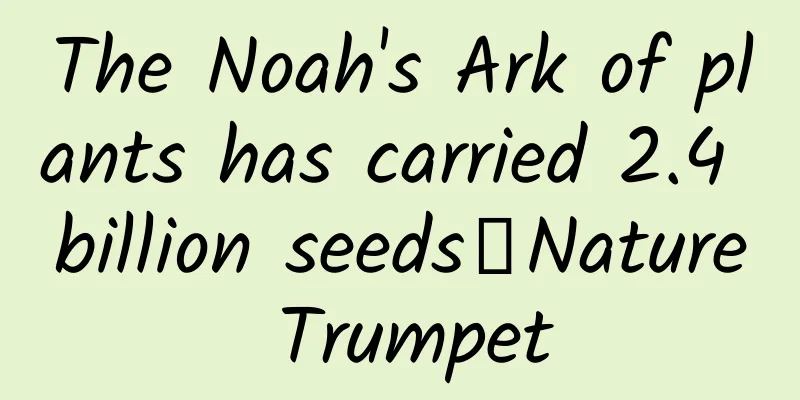The Noah's Ark of plants has carried 2.4 billion seeds丨Nature Trumpet

|
Welcome to the 30th issue of the Nature Trumpet column. In the past half month, we have collected the following natural news and research worth noting: 1) Two fathers can also produce offspring 2) The mysterious "Cat-Fox" is revealed 3) Coffee may be driving birds to extinction 4) The Noah’s Ark of plants has 2.4 billion seeds 5) The longest dinosaur neck is 6 times longer than a giraffe’s 6) Fossils were viewed from the wrong angle, causing decades of confusion "Boys giving birth to children" Recently, scientists developed new technology that allowed two male mice to produce offspring ! Mouse | Rama / Wikimedia Commons This sounds like an impossible task. Male mice have XY sex chromosomes, while female mice have XX. Two male reproductive cells cannot produce a fertilized egg - how to solve the problem of chromosome matching? The scientists first took skin cells from the tails of male mice, programmed them to become induced pluripotent stem cells, and then selected stem cells with Y chromosome deletions and cultivated them into XX pluripotent stem cells, which eventually produced egg cells . Next, they used sperm from another male mouse to combine with this " artificially sex-transferred " egg cell to form a normal fertilized egg. In the end, 7 of the 630 embryos grew into mouse pups, which not only survived successfully but were also able to reproduce normally . Five of the seven mice survived | Reference [1] This research has opened up a new path in reproductive biology. Using this technology, in the future, we may be able to use male animals to breed endangered mammals and prevent them from extinction ; for humans, some people who are unable to have children due to diseases , or same-sex couples , may also have the hope of using this technology to have their own children . However, this technology is still in its infancy. Scientists still need to solve many problems. For example, the success rate of this technology is very low, and only about 1% of embryos can survive . Mysterious Cat-Fox The mysterious " cat-fox " living on the island of Corsica has finally been identified in the scientific community! Cat-fox on the French island of Corsica | References [2] The cat-fox, known locally as ghjattu volpe, has been known for hundreds of years. In myths passed down by shepherds, they are elusive bullies who raid sheepfolds in the middle of the night. But no one has ever documented their true appearance , so their true identity in science remains a mystery. In 2006, a cat-fox was accidentally trapped in a chicken pen, and everyone got to see their full appearance. At first glance, they look no different from ordinary orange cats, but they are still unique - they are larger, about 90 cm from head to tail, and their tails have ring patterns and black tips . Cat Fox: I look like a big orange cat, but I am not a big orange cat! | References [2] Recently, researchers conducted genetic testing on cat-foxes and finally revealed their true identity. The researchers captured cat-foxes using a very friendly method - bait was placed in a box, and the cat-foxes entered on their own (no cat can refuse a box). Samples taken from these cat-foxes and dead cat-fox tags showed that cat-foxes are neither domestic cats nor European wildcats . They belong to a separate species, which is genetically more similar to Asian and African wildcats . Collared cat-fox released back into the wild | Martin Boone Before the captured cat-fox is returned to the wild, it is fitted with an electronic collar to track its location . Researchers hope that the study of cat-fox can help people understand the existence of this mysterious species and thus pay more attention to and protect them . Bird-Friendly Coffee When we pick up a cup of coffee every day, we may not imagine that birds may be facing survival difficulties because of coffee . In Costa Rica, 50% of forests have been converted to coffee plantations . Coffee plantations lack insects and other invertebrates, and entire tracts of forest have been replaced by coffee plantations, which is equivalent to the closure of all cafeterias for birds. Recently, scientists studied the diets of four bird species and found that the number of insects they ate in coffee plantations was only half that in the forest . Birds tracked in the experiment: Silver-throated Tanager | Çağan H. Şekercioğlu Birds with high mobility can also fly to the remaining forests to forage and find enough food to fill their stomachs. But for birds with low mobility, this is tantamount to a catastrophe : for example, the orange-bellied night thrush tracked in the experiment, their activity range is only half a hectare in their lifetime, and they only have two choices before them - change their diet or starve to death . Even if birds move to another place to find food, it will bring new problems - in the new territory, they may need to compete with other birds, and there may not be enough insects to eat in the new territory (Insects: I am miserable too). The Orange-bellied Nightthrush has a very small home range throughout its life. | Nigel Voaden / Wikimedia Commons In order to protect birds, coffee companies and governments can encourage the planting of bird-friendly coffee - " shade coffee ". Shade coffee grows under the canopy of trees, which means that the trees can be preserved to the greatest extent and the food for birds can be guaranteed. Currently, Ethiopia's shaded coffee can be said to be the most bird-friendly coffee in the world. However, we must not forget that shaded coffee cannot replace forests. For birds, forests will always be the most suitable home for them . Plant Noah's Ark This month, the Millennium Seed Bank in the UK reached a milestone: the number of seeds stored in the seed bank exceeded 2.4 billion , from about 40,000 different wild plant species . The Millennium Seed Bank is currently the world's largest wild plant seed storage facility, known as the "Noah's Ark" of plants. It has the world's most diverse plant collection, with seeds from 190 countries and regions . These buildings are just the tip of the iceberg of the Millennium Seed Bank, and there is a huge seed preservation facility underground | Wikipedia After the seeds arrive at the Millennium Seed Bank from all over the world, the staff will first dry and clean the seeds, and then use X-rays to check for insect pests and embryonic maldevelopment. After drying again, the seeds, which now have a moisture content of only about 3-6%, will be sealed and placed in a -20˚C cold room. Under such conditions, they can survive for more than 100 years . Every 10 years, the seeds will be taken out for germination tests to ensure their vitality. If the germination rate is too low, the seeds need to be updated in time. Seed Bank | RBG Kew / Andrew McRobb But there are still 8%-20% of flowering plant seeds that cannot tolerate dehydration and therefore cannot be preserved after drying. In order to preserve the seeds of these plants, scientists are studying the ultra-low temperature preservation technology of plants, that is, storing plants in liquid nitrogen at -196℃. The Millennium Seed Bank is not only an insurance policy for the end of the world, but also an important resource for saving endangered plants. Scientists estimate that due to habitat loss and climate change, two-fifths of the world's wild plants are now threatened with extinction, and seed banks will be the hope for the recovery of these species. Longest dinosaur neck The longest dinosaur neck may be 15.1 meters long, which is 6 times longer than that of a giraffe ! Reconstruction of the Sino-Canadian Mamenchisaurus. How did it keep its balance? | Júlia d'Oliveira The owner of the longest neck is Mamenchisaurus sinocanadorum . In 1987, paleontologists from China and Canada discovered the fossil of Mamenchisaurus sinocanadorum in Xinjiang, China. It is the largest Mamenchisaurus , with a body length of about 35 meters and a weight of more than 60 tons . Wouldn't a long neck weigh down the body? The Chinese-Canadian Mamenchisaurus had 18 cervical vertebrae, and CT scans of the vertebrae showed that air accounted for 77% of the vertebrae's volume , allowing its neck to be large and light. In order to protect this long neck, it had 4-meter-long cervical ribs on its neck, which increased the stability of the neck, but also reduced its flexibility accordingly. Fossil of Mamenchisaurus mesocanus | Kabacchi / Wikimedia Commons What is amazing is not only the length of the neck, but also the biological challenges that come with it - just imagine that every time you breathe or eat, the gas or food has to travel 15 meters from the mouth and nose to reach the body; in the circulatory system, in order for blood to flow to the brain, the power generated by the heart must allow the blood to overcome gravity and flow 15 meters upward. These huge and mysterious ancient creatures, with their remaining bones, constantly challenge human cognition. The fossil is upside down There has been a huge mistake in the world of paleontology that has lasted for more than 50 years! People have been mistaking a 300 million-year-old sea anemone fossil for a jellyfish because they placed the fossil upside down ! This "jellyfish" fossil is called Essexella Asherae. It has been found in the Mazon Creek fossil bed in Illinois, USA since 1971. It is the most common fossil in the area. For decades, they have been the most famous **"jellyfish" fossils**. Essexella Asherae fossil and reconstruction | References [6] However, when paleontologist Roy Plotnick observed these fossils recently, he always felt that something was wrong - the upper part did not look like the umbrella of a jellyfish, but rather the muscular legs of an anemone ; and it did not have the tentacles under the umbrella of a modern jellyfish, but only a membrane-like "skirt". However, if the fossils are turned upside down , everything makes sense - the "skirt" is actually the barrel-shaped body of the anemone, and the "umbrella" is the muscle tissue that the anemone uses to drill into the seabed. Some examples of modern sea anemones | Plotnick et al., 2023 Roy and his colleagues observed thousands of fossils of Essexella Asherae and found more evidence: the stripes on the fossils are very similar to the muscle tissue of some modern anemones ; some of the protrusions on the fossils look very much like the tentacles of modern anemones . In addition, the snail fossils attached to them are not the ancestors of modern jellyfish parasites, but scavengers that feed on the corpses of sea anemones and were accidentally buried with them. Because the fossils were taken the wrong way, scientists not only misidentified the fossils, but also classified them into another family. Now Essexella Asherae has finally been corrected and returned to the classification of sea anemones . References https://www.nature.com/articles/s41586-023-05834-x https://phys.org/news/2023-03-mysterious-corsican-cat-fox-revealed-unique.html https://www.frontiersin.org/articles/10.3389/fevo.2023.1086616/full https://phys.org/news/2023-03-noah-ark-major-milestone-species.html https://www.livescience.com/longest-dinosaur-neck-ever-stretched-further-than-a-school-bus-at-49-feet-long https://www.livescience.com/oops-this-300-million-year-old-blob-fossil-was-upside-down-its-not-a-jellyfish-after-all Author: Cat Tun Editor: Mai Mai This article comes from the Species Calendar, welcome to forward If you need to reprint, please contact [email protected] |
<<: 80% of people have experienced flashing eyes. Is this actually a disease?
>>: What may be causing your allergies is not the flowers and plants, but the tall trees
Recommend
A complete guide to starting a new Tik Tok account!
1. Background The development of technology is th...
11 open source projects for machine learning
Machine learning is a hot topic in the field of d...
Urban survival tool, WI-1000XM2 or QuietControl 30 noise reduction is better?
Noise-cancelling headphones have become a standar...
Tik Tok live streaming and algorithm mechanism
With 0 fans and purely natural flow, how to achie...
European Automobile Manufacturers Association: Tesla's European sales fell 45% year-on-year to 9,945 units in January 2024
As demand for electric vehicles surges in Europe, ...
How come “big fat meat” and “little maggots” grow in vinegar?
Vinegar, as a common condiment, is often used in ...
Will the COVID-19 pandemic spread in space?丨Young looks up at the stars and chases his dreams
Before we know it, time has already arrived at th...
Tencent WeChat Enterprise Account starts public beta testing to provide mobile application access
Recently, Tencent's WeChat Enterprise Account...
Ancient little beast: Although I grow slowly, I live long!
Feng Weimin Recently, an article published in the...
How to choose vinegar? Is vinegar really nutritious?
I have talked with friends before about how to ch...
How does "Meipian", which has 80 million users, conduct content operations?
Meipian's slogan is to record the beauty and ...
Xiaomi is on the left and Meizu is on the right
Meizu has been waiting for a long time for the op...
A brief discussion on the geological period of reservoirs in my country's main oil and gas regions
my country has a vast territory, with 9.6 million...
Understand the HAL hardware abstraction layer in the Android system architecture
Introduction to HAL HAL refers to the Hardware Ab...









